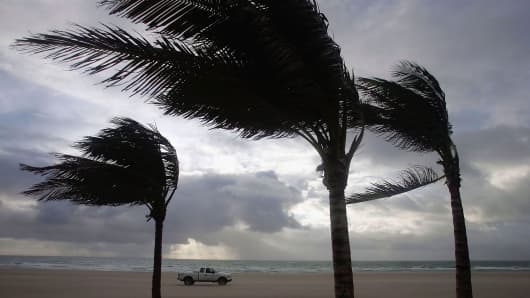Sure, it's time for summer fun, but hurricane season is also upon us. And that means you have work to do with your homeowner's insurance.
Major storms have a way of making insurers re-examine what they are covering, and at what price. And in the wake of Hurricane Sandy, which caused tens of billions of dollars in damages, you can bet that policies are getting a close look.
(View More: 10 Most Expensive Hurricanes in U.S. History)
For starters, consider your hurricane coverage. It's probably already different from most of your coverage, which kicks in after a set deductible. Damage from a hurricane tends to be covered after a deductible of a fixed percentage of the value of your home.
That exception for hurricane damage can mean thousands of dollars out of pocket for the owner of a high-priced home. The average price of a home sold in May on Long Beach Island, N.J., an area hard hit by Sandy, was $723,000.
(View More: Scenes From Hurricane Sandy)
Hurricane deductibles were not a factor after Sandy struck the Northeast, since by the time it made landfall, it had been downgraded below hurricane status and policyholders could collect under their regular coverage.
But insurers are finding ways to keep that from happening again, and that means more homeowners could find themselves paying significantly more out of pocket after a storm strikes.
(Read More: Why Insurers May Be Unprepared for the Next Big Storm)
"You certainly see that after a big catastrophic event, where insurance companies will try to scale back their coverage," said Jared Zola, who leads the insurance coverage group for the Northeast for Dickstein Shapiro. "As the world changes, insurance companies try to limit their risk."
An April insurance market analysis by Napco, a wholesale broker of commercial property and casualty insurance, found that many insurers are rewording their hurricane deductibles so that they apply to any windstorm big enough to get a name from the National Weather Service. Not only that, some insurers have increased their windstorm deductibles tenfold, the analysis found.
David Pagoumian, chief executive of Napco, based in Iselin, N.J., sees other changes in the works as well. Warming oceans are making the Northeast increasingly vulnerable to frequent, severe hurricanes and storms of the kind that regularly batter Florida. "So what's happening is the insurance industry and industry executives are starting to deploy certain tactics that's we've used in Florida and bringing them up here."
That means, for example, that in addition to expanding the reach of what was the hurricane deductible, insurers are also tightening ambiguities in policies regarding coverage for things like storm surges. For example, in the past, if homeowners suffered wind damage from a hurricane and then experienced flooding from the storm surge, their insurance company might have paid for damages from the flooding. But now insurers are trying to reword policies so that their obligation to deal with this kind of two-part damage is limited.
"The trend is policy language being better defined as to the losses that occur with hurricanes, whether it's wind driven rain, or the storm surge and flooding," Pagoumian said.
There is also the chance that insurers will seek to flat out raise their rates, or even reduce the number of policies they issue in areas that are increasingly vulnerable to storms.
(Read More: Weather Changes to Blame for Insurance Rate Hikes)
How can you protect yourself from the coming storm of insurance changes?
For starters, read your policy and make sure you understand exactly what is covered, and for how much.
"No one really reads their insurance policy, right? I don't even read mine, and I'm in the business," Pagoumian said. But it's important.
(Read More: Four Questions to Ask Before Hurricane Season Hits)
For an expensive home with significant storm exposure, consider a commercial policy to supplement your homeowner's coverage. "People even before Sandy had purchased on the commercial market policies that included some degree of coverage for flood or named windstorm," Zola said.
If your rates are going up sharply, and you have a tolerance for risk, it's worth considering a form of self insurance. You can take out a policy with a fairly high deductible for hurricanes or windstorms, and then set aside what you save on your premium in case of storm damage.
Whatever you do, be prepared for changes ahead.
"In seeking recovery from Sandy, we are seeing what insurance companies did in response to Katrina," Zola warned. Many policyholders have not yet renewed their policies following Sandy, and when they do, they will see how insurers really plan to take shelter from the next big storm.



